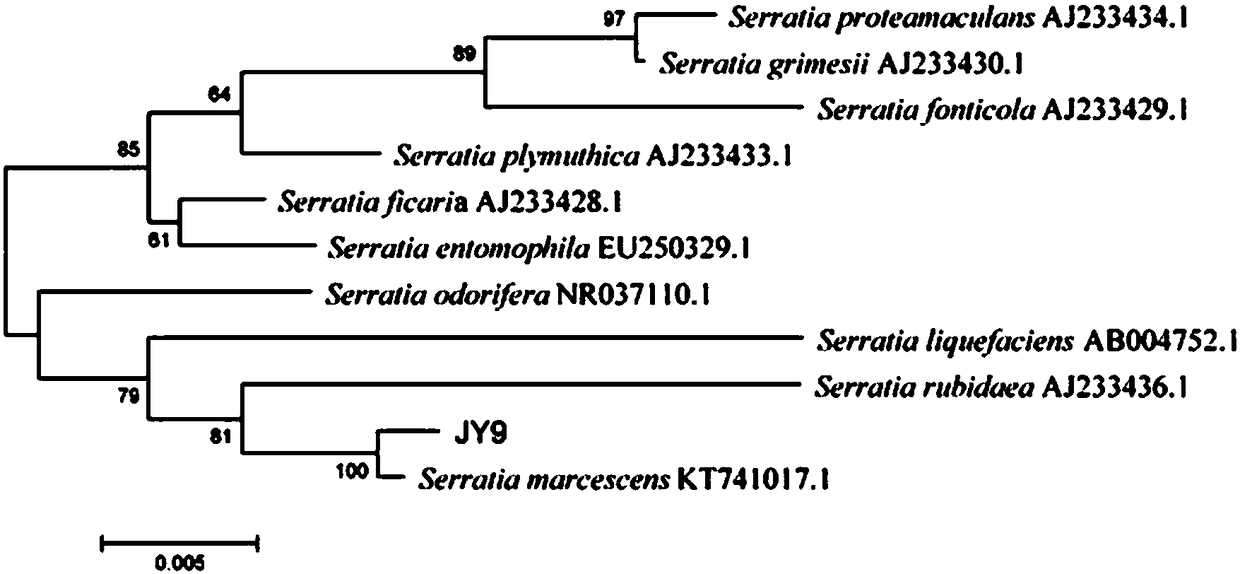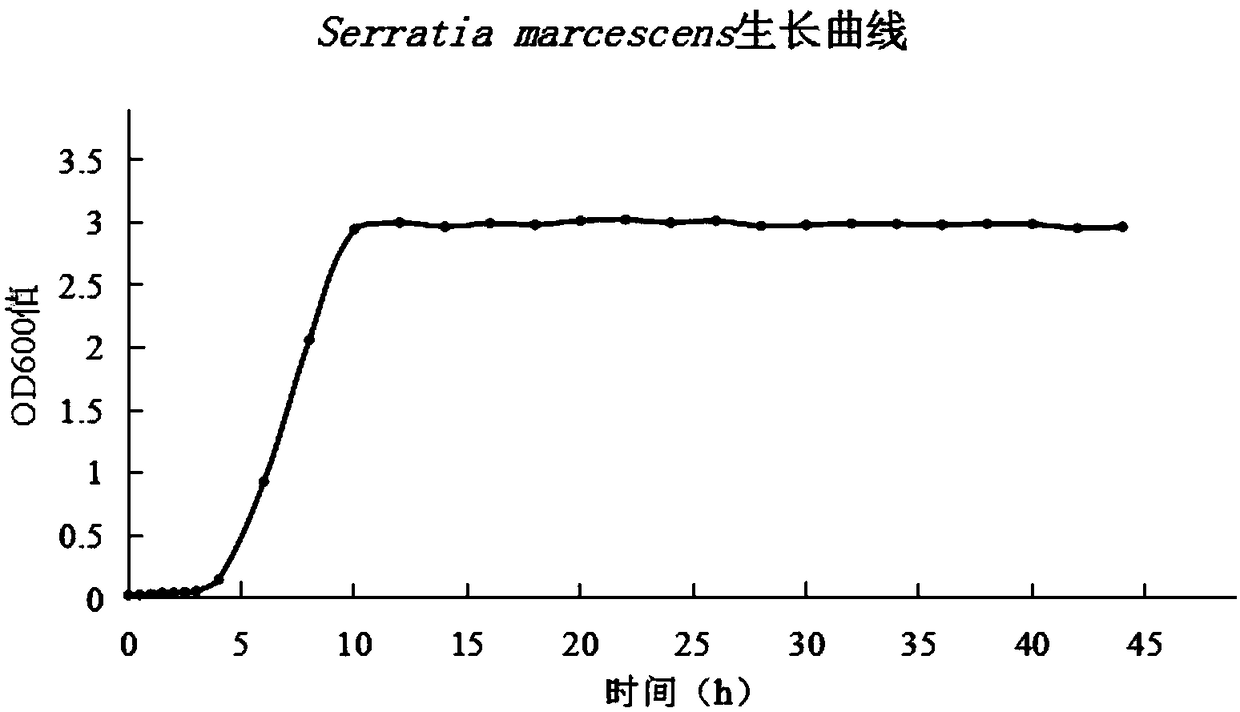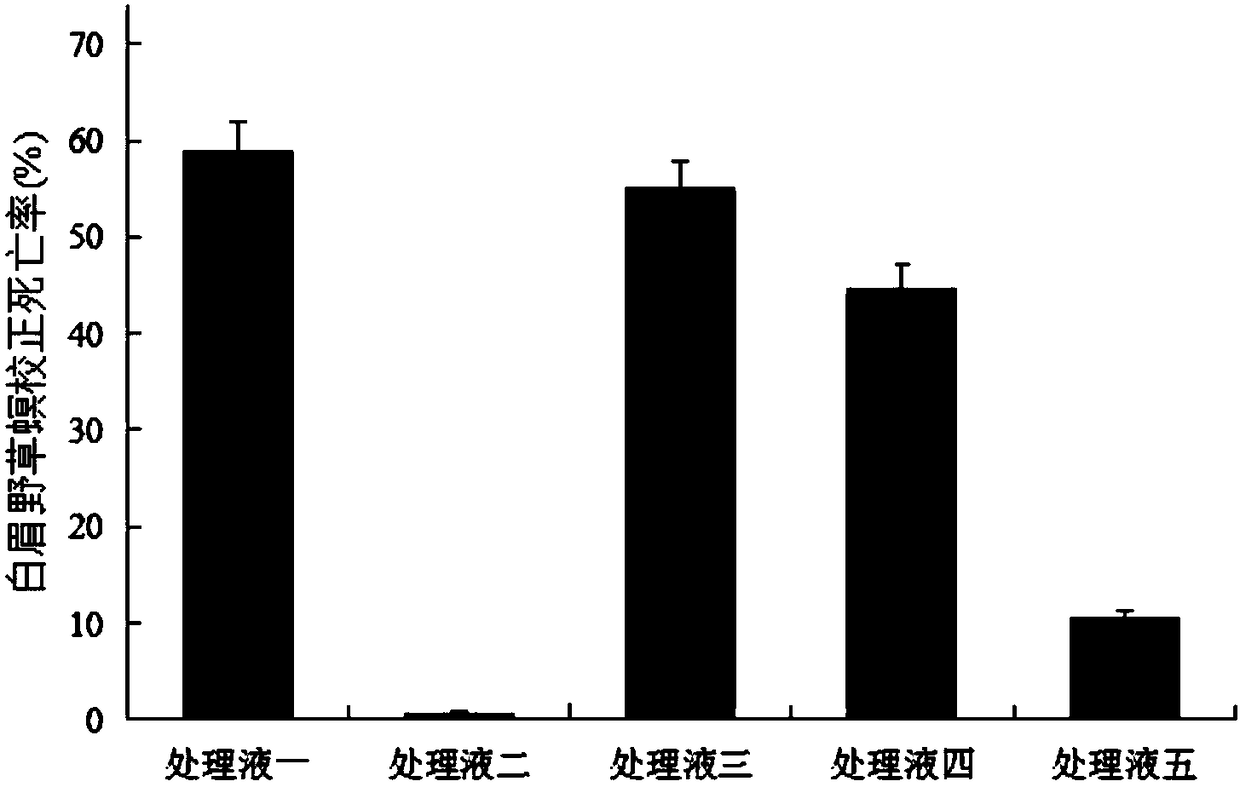Serratia marcescens derived from agriphilaaeneociliella diseased insect bodies and application thereof
A technology of Serratia marcescens and bacterial suspension, applied in the field of agricultural microorganisms
- Summary
- Abstract
- Description
- Claims
- Application Information
AI Technical Summary
Problems solved by technology
Method used
Image
Examples
Embodiment 1
[0049] Example 1: Isolation and identification of bacterial strains
[0050] 1. Isolation of strains:
[0051] (1) Soak the diseased larvae of the chrysalis moth in 75% alcohol for 10 seconds, disinfect the body surface, rinse them with sterile water for 3 times, put them into a sterile petri dish, and cut them off with sterilized surgical scissors At the end of one of the feet, use a pipette to absorb 5 μl of the overflowing body fluid, add 495 μl of sterile water to dilute, and then continue to dilute with sterile water to form a sterile water dilution of 1:10 2 , 1:10 3 , 1:10 4 , 1:10 5 diluent, and finally fully shaken;
[0052] (2) The dilution in the drawing step (1) is 1:10 2 , 1:10 3 , 1:10 4 , 1:10 5 50 μl each of the dilutions were spread on LB solid medium without anti-antibody, and cultured at 28°C for 24 hours;
[0053] (3) Pick a single colony grown after 24 hours of cultivation, and then culture it purely on LB solid medium to obtain strain JY9.
[00...
Embodiment 2
[0080] Embodiment 2: the growth curve determination of strain JY9 fermented liquid OD600 value changes with culture time
[0081] Get the single bacterium colony on the JY9 bacterial strain plate that embodiment 1 obtains and inoculate in the Erlenmeyer flask that 100ml LB medium is housed, culture temperature is 28 ℃, shaking table speed 180rpm, culture time 12h, obtain Serratia marcescens JY9 ferment liquid, add LB to dilute, and adjust the OD600 value of this fermentation liquid to 1.0 (the bacterial concentration at this time is about 6×10 8 cfu / ml), it was inoculated into 150 5ml centrifuge tubes equipped with 2ml LB according to the inoculum amount of 1%, and they were all placed in a shaker at 28°C with a rotation speed of 180rpm, shaken for 48h, and at the same time, every 0.5 Take 3 centrifuge tubes for h, and then take 3 centrifuge tubes every 2 hours, and measure their OD600 values respectively. Draw the growth curve of Serratia marcescens strain JY9 fermentation...
Embodiment 3
[0083] Example 3: Determination of the control ability of Serratia marcescens strain JY9 to the weed moth
[0084] 1. Test method:
[0085] (1) Preparation of bacterial strain JY9 fermentation broth:
[0086] Inoculate a single colony of strain JY9 that was streak cultured on LB solid medium at 28°C for 16 hours into 6ml of LB liquid medium, place it on a shaker at 28°C, and cultivate it at 180rpm for 16 hours as a seed solution, and then use a pipette Take 100 μl of Serratia marcescens JY9 seed liquid with a liquid gun, inoculate it into 100 ml of sterilized LB liquid medium according to the inoculation amount of 1% (volume ratio), place it on a shaker at 28°C, and cultivate it at 180 rpm for 16 hours to obtain the strain The fermentation broth of JY9.
[0087] (2) Preparation of treatment liquid:
[0088] 1) Take 10ml of the fermentation broth of the bacterial strain JY9 prepared in (1) above, and adjust its OD600 value to 1.0 (the bacterial concentration is about 6×10 8...
PUM
 Login to View More
Login to View More Abstract
Description
Claims
Application Information
 Login to View More
Login to View More - R&D
- Intellectual Property
- Life Sciences
- Materials
- Tech Scout
- Unparalleled Data Quality
- Higher Quality Content
- 60% Fewer Hallucinations
Browse by: Latest US Patents, China's latest patents, Technical Efficacy Thesaurus, Application Domain, Technology Topic, Popular Technical Reports.
© 2025 PatSnap. All rights reserved.Legal|Privacy policy|Modern Slavery Act Transparency Statement|Sitemap|About US| Contact US: help@patsnap.com



